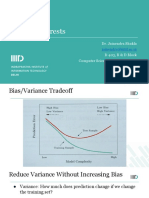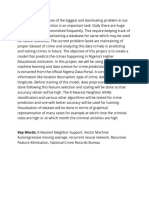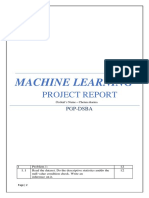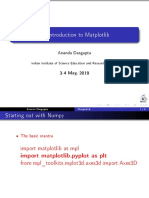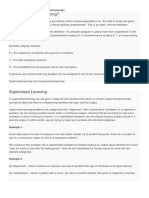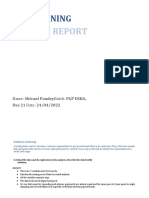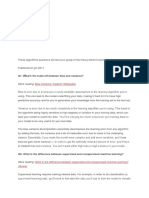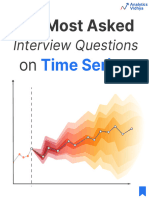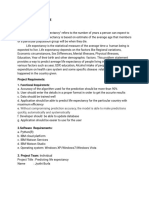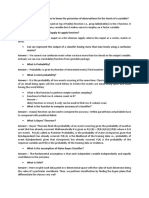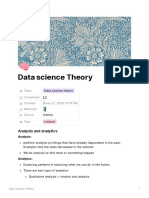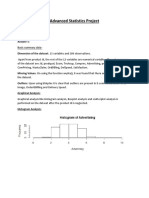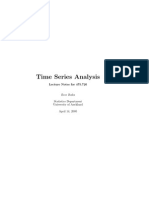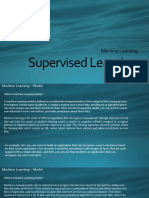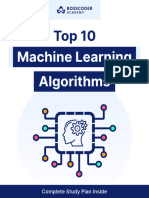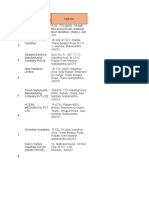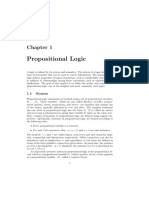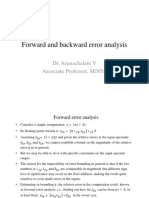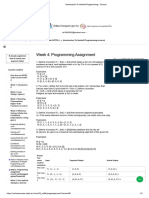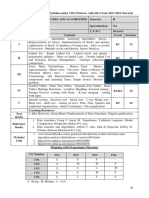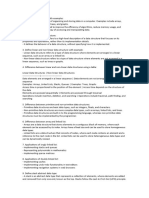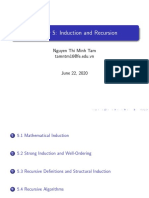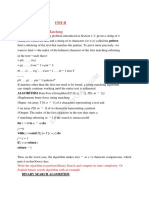MACHINE LEARNING MASTERS PROGRAM
DURATION : 7 MONTHS
+ 3 months internship
Section: 1
Python Fundamentals
1. Introduction to the course
2. Introduction to Kaggle
3. Installation of Python and Anaconda
• Installing-Python.Teclov.pdf
• Python-code-udemy.zip
4. Python Introduction
• Python-code-udemy.zip
5. Variables in Python
6. Numeric Operations in Python
7. Logical Operations
8. If else Loop
9. for while Loop
10. Functions
11. String Part1
12. String Part2
13. List Part1
14. List Part2
15. List Part3
16. List Part4
17. Tuples
18. Sets
19. Dictionaries
20. Comprehentions
Section: 2
Numpy
21. Introduction
22. Numpy Operations Part1
23. Numpy Operations Part2
Section: 3
Pandas
24. Introduction
• Pandas.zip
25. Series
26. DataFrame
27. Operations Part1
28. Operations Part2
29. Indexes
30. loc and iloc
31. Reading CSV
32. Merging Part1
33. groupby
34. Merging Part2
35. Pivot Table
�MACHINE LEARNING MASTERS PROGRAM
DURATION : 6 MONTHS
Section: 4
Some Fun With Maths
36. Linear Algebra : Vectors
37. Linear Algebra : Matrix Part1
38. Linear Algebra : Matrix Part2
39. Linear Algebra : Going From 2D to nD Part1
40. Linear Algebra : 2D to nD Part2
Section: 5
Inferential Statistics
41. Inferential Statistics
42. Probability Theory
43. Probability Distribution
44. Expected Values Part1
45. Expected Values Part2
46. Without Experiment
47. Binomial Distribution
48. Commulative Distribution
49. PDF
50. Normal Distribution
51. z Score
52. Sampling
53. Sampling Distribution
54. Central Limit Theorem
55. Confidence Interval Part1
56. Confidence Interval Part2
Section: 6
Hypothesis Testing
57. Introduction
• t-table.pdf
• z-table.pdf
58. NULL And Alternate Hypothesis
59. Examples
60. One/Two Tailed Tests
61. Critical Value Method
62. z Table
63. Examples
64. More Examples
65. p Value
66. Types of Error
67. t- distribution Part1
68. t- distribution Part2
Section: 7
Data Visualisation
69. Matplotlib
• Datavisual.zip
�MACHINE LEARNING MASTERS PROGRAM
DURATION : 6 MONTHS
70. Seaborn
71. Case Study
72. Seaborn On Time Series Data
Section: 8
Exploratory Data Analysis
73. Introduction
74. Data Sourcing and Cleaning part1
75. Data Sourcing and Cleaning part2
76. Data Sourcing and Cleaning part3
77. Data Sourcing and Cleaning part4
78. Data Sourcing and Cleaning part5
79. Data Sourcing and Cleaning part6
80. Data Cleaning part1
81. Data Cleaning part2
82. Univariate Analysis Part1
83. Univariate Analysis Part2
84. Segmented Analysis
85. Bivariate Analysis
86. Derived Columns
Section: 9
Simple Linear Regression
87. Introduction to Machine Learning 2:12
• code-LR-Teclov.zip
88. Types of Machine Learning
89. Introduction to Linear Regression (LR)
90. How LR Works?
91. Some Fun With Maths Behind LR
92. R Square
93. LR Case Study Part1
94. LR Case Study Part2
95. LR Case Study Part3
96. Residual Square Error (RSE)
Section: 10
Multiple Linear Regression
97. Introduction
• Multplr_LR_Code_for Udemy.zip
98. Case Study part1
99. Case Study part2
100. Case Study part3
101. Adjusted R Square
102. Case Study Part1
103. Case Study Part2
104. Case Study Part3
105. Case Study Part4
�MACHINE LEARNING MASTERS PROGRAM
DURATION : 6 MONTHS
106. Case Study Part5
107. Case Study Part6 (RFE)
Section: 11
Hotstar/Netflix: Real world Case Study for Multiple Linear Regression
108. Introduction to the Problem Statement 5:17
• Hotstarcode-for-udemy.zip
109. Playing With Data
110. Building Model Part1
111. Building Model Part2
112. Building Model Part3 3
113. Verification of Model
Section: 12
Gradient Descent
114. Pre-Req For Gradient Descent Part1
• Gradient+Descent+Updated.zip
115. Pre-Req For Gradient Descent Part2
116. Cost Functions
117. Defining Cost Functions More Formally
118. Gradient Descent
119. Optimisation
120. Closed Form Vs Gradient Descent
121. Gradient Descent case study
Section: 13
KNN
122. Introduction to Classification 12:54
• KNN.zip
123. Defining Classification Mathematically
124. Introduction to KNN
125. Accuracy of KNN
126. Effectiveness of KNN
127. Distance Metrics
128. Distance Metrics Part2
129. Finding k
130. KNN on Regression
131. Case Study
132. Classification Case1
133. Classification Case2
134. Classification Case3
135. Classification Case4
Section: 14
�MACHINE LEARNING MASTERS PROGRAM
DURATION : 6 MONTHS
Model Performance Metrics
136. Performance Metrics Part1
137. Performance Metrics Part2
138. Performance Metrics Part3
Section: 15
Model Selection Part1
139. Model Creation Case1
• CrossValidation_Linear Regression.zip
140. Model Creation Case2
141. Gridsearch Case study Part1 1
142. Gridsearch Case study Part2
Section: 16
Naive Bayes
143. Introduction to Naive Bayes
• NaiveBayes.zip
144. Bayes Theorem
145. Practical Example from NB with One Column
146. Practical Example from NB with Multiple Columns
147. Naive Bayes On Text Data Part1
148. Naive Bayes On Text Data Part2
149. Laplace Smoothing
150. Bernoulli Naive Bayes
151. Case Study 1
152. Case Study 2 Part1 6
153. Case Study 2 Part2
Section: 17
Logistic Regression
154. Introduction
• LogisticReg.zip
155. Sigmoid Function
156. Log Odds
157. Case Study
Section: 18
Support Vector Machine (SVM)
158. Introduction
• SVM.zip
159. Hyperplane Part1
160. Hyperplane Part2
161. Maths Behind SVM
162. Support Vectors
163. Slack Variable
�MACHINE LEARNING MASTERS PROGRAM
DURATION : 6 MONTHS
164. SVM Case Study Part1
165. SVM Case Study Part2
166. Kernel Part1
167. Kernel Part2
168. Case Study : 2
169. Case Study : 3 Part1
170. Case Study : 3 Part2
171. Case Study 4
Section: 19
Decision Tree
172. Introduction
• DT_forudemy.zip
173. Example of DT
174. Homogenity
175. Gini Index
176. Information Gain Part1
177. Information Gain Part2
178. Advantages and Disadvantages of DT
179. Preventing Overfitting Issues in DT
180. DT Case Study Part1
181. DT Case Study Part2
Section: 20
Ensembling
182. Introduction to Ensembles
• RF_forudemy.zip
• Boosting.zip
183. Bagging
184. Advantages
185. Runtime
186. Case study
187. Introduction to Boosting
188. Weak Learners
189. Shallow Decision Tree
190. Adaboost Part1
191. Adaboost Part2
192. Adaboost Case Study
193. XGBoost
194. Boosting Part1
195. Boosting Part2
196. XGboost Algorithm
197. Case Study Part1
198. Case Study Part2
199. Case Study Part3
Section: 21
�MACHINE LEARNING MASTERS PROGRAM
DURATION : 6 MONTHS
Model Selection Part2
200. Model Selection Part1
201. Model Selection Part2
202. Model Selection Part3
Section: 22
Unsupervised Learning
203. Introduction to Clustering
• Unsupervised.zip
204. Segmentation
205. Kmeans
206. Maths Behind Kmeans
207. More Maths
208. Kmeans plus
209. Value of K
210. Hopkins test
211. Case Study Part1
212. Case Study Part2
213. More on Segmentation
214. Hierarchial Clustering
215. Case Study
Section: 23
Dimension Reduction
216. Introduction
• PCA code for udemy.zip
217. PCA
218. Maths Behind PCA
219. Case Study Part1
220. Case Study Part2
Section: 24
Advanced Machine Learning Algorithms
221. Introduction
• AdvanceReg.zip
222. Example Part1
223. Example Part2
224. Optimal Solution
225. Case study
226. Regularization
227. Ridge and Lasso
228. Case Study
229. Model Selection
230. Adjusted R Square
Section: 25
�MACHINE LEARNING MASTERS PROGRAM
DURATION : 6 MONTHS
Deep Learning
231. Expectations
232. Introduction
233. History
234. Perceptron
235. Multi Layered Perceptron
236. Neural Network Playground
Section: 26
Project : Kaggle
237. Introduction to the Problem Statement
• training.zip
• Teclov Project - Medical treatment.ipynb.zip
238. Playing With The Data
239. Translating the Problem In Machine Learning World
240. Dealing with Text Data
241. Train, Test And Cross Validation Split
242. Understanding Evaluation Matrix: Log Loss
243. Building A Worst Model
244. Evaluating Worst ML Model
245. First Categorical column analysis
246. Response encoding and one hot encoder
247. Laplace Smoothing and Calibrated classifier
248. Significance of first categorical column
249. Second Categorical column
250. Third Categorical column
251. Data pre-processing before building machine learning model
252. Building Machine Learning model :part1
253. Building Machine Learning model :part2
254. Building Machine Learning model :part3
255. Building Machine Learning model :part4
256. Building Machine Learning model :part5
257. Building Machine Learning model :part6
PROJECTS ON STATS
PROJECTS ON ML
NATURAL LANGUAGE PROCESSING
LEXICAL PROCESSING
Introduction to NLP
1.NLP: Areas of Application
2.Understanding Text
3.Text Encoding
4.Regular expressions: Quantifiers - I
�MACHINE LEARNING MASTERS PROGRAM
DURATION : 6 MONTHS
5.Regular Expressions: Quantifiers - II
6.Comprehension: Regular Expressions
7.Regular Expressions: Anchors and Wildcard
8.Regular Expressions: Characters Sets
9Greedy versus Non-greedy Search
10Commonly Used RE Functions
11.Regular Expressions: Grouping
12.Regular Expressions: Use Cases
13.Summary
14.Graded Questions
Basic Lexical Processing
1.Introduction
2.Word Frequencies and Stop Words
3.Tokenisation
4.Bag-of-Words Representation
5.Stemming and Lemmatization
6.Final Bag-of-Words Representation
7.TF-IDF Representation
8.Building a Spam Detector - I
9.Building a Spam Detector - II
10.Summary
11.Graded Questions
Advanced Lexical Processing
1.Introduction
2.Canonicalisation
3.Phonetic Hashing
4.Edit Distance
5.Spell Corrector - I
6.Spell Corrector - II
7.Pointwise Mutual Information - I
8.Pointwise Mutual Information - II
9.Summary
10.Graded Questions
SYNTACTICAL PROCESSING
Introduction to Syntactic Processing
1.Introduction
2.The What and Why of Syntactic Processing
3.Parsing
4.Parts-of-Speech
5.Different Approaches to POS Tagging
6.Lexicon and Rule-based POS Tagging
7.Stochastic Parsing
8.The Viterbi Heuristic
�MACHINE LEARNING MASTERS PROGRAM
DURATION : 6 MONTHS
9.Markov Chain and HMM
10.Explanation Problem
11.Learning HMM Model Parameters
12.HMM and the Viterbi Algorithm: Pseudocode
13.HMM & the Viterbi Algorithm: Python Implementation
14.Deep Learning Based POS Taggers
15.Summary
16.Graded Questions
Parsing
1.Introduction
2.Why Shallow Parsing is Not Sufficient
3.Constituency Grammars
4.Top-Down Parsing
5.Bottom-Up Parsing
6.Probabilistic CFG
7.Chomsky Normal Form
8.Dependency Parsing
9.Summary
10.Graded Questions
Information Extraction
1.Introduction
2.Understanding the ATIS data
3.Information Extraction
4.POS Tagging
5.Rule-Based Models
6.Probabilistic Models for Entity Recognition
7.Naive Bayes Classifier for NER
8.Decision Tree Classifiers for NER
9.HMM and IOB labelling
10.Summary
11.Graded Questions
12.CRFs - Another Probabilistic Approach
Conditional Random Fields
1.Introduction to Conditional Random Fields (CRFs)
2.CRF Model Architecture - I
3.CRF Model Architecture - II
4.Training a CRF model
5.Predicting using CRF
6.Python Implementation of CRF
Semantic Processing
Introduction to Semantic Processing
1.Introduction
2.Concepts and Terms
3.Entity and Entity Types
�MACHINE LEARNING MASTERS PROGRAM
DURATION : 6 MONTHS
4.Arity and Reification
5.Schema
6.Semantic Associations
7.Databases - WordNet and ConceptNet
8.Word Sense Disambiguation - Naive Bayes
9.Word Sense Disambiguation - Lesk Algorithm
10.Lesk Algorithm Implementation
11.Summary
12.Graded Questions
Distributional Semantics
1.Introduction
2.Introduction to Distributional Semantics
3.Occurrence Matrix
4.Co-occurrence Matrix
5.Word Vectors
6.Word Embeddings
7.Latent Semantic Analysis (LSA)
8.Comprehension - Latent Semantic Analysis
9.Skipgram Model
10.Comprehension - Word2Vec
11.Generate Vectors using LSA
12.Word2vec in Python - I
13.Word2vec and GloVe in Python - II
14.Word2vec and GloVe in Python - III
15.Basics of Topic Modelling with ESA
16.Introduction to Probabilistic Latent Semantics Analysis (PLSA)
17.Summary
18.Graded Questions
19.What's Next in Semantic Processing?
Topic Modelling
1.Introduction
2.Introduction to Topic Modelling
3.The Output of a Topic Model
4.Defining a Topic
5.Matrix Factorisation Based Topic Modelling
6.Probabilistic Model
7.Probabilistic Latent Semantic Analysis (PLSA)
8.Expectation Maximization in PLSA
9.Comprehension - Multinomial Distribution in Topic Modelling
10.Latent Dirichlet Allocation (LDA)
11.LDA - An extension of PLSA
12.Use LDA to Generate a Corpus
13.Parameter Estimation using Gibbs Sampling
14.LDA in Python - I
15.LDA in Python - II
16.LDA in Python - III
17.Summary
�MACHINE LEARNING MASTERS PROGRAM
DURATION : 6 MONTHS
18.Questions for Practice
Social Media Opinion Mining - Semantic Processing Case Study
1.Introduction
2.The Problem Statement
3.Project Pipeline
4.Python code - I
5.Python code - II
PROJECTS
DEEP LEARNING & NEURAL NETWORKS
INFORMATION FLOW IN A NEURAL NETWORK
Understand the components and structure of artificial neural networks
TRAINING A NEURAL NETWORK
Learn the cutting-edge techniques used to train highly complex neural networks
CONVOLUTIONAL NEURAL NETWORKS
Use CNN's to solve complex image classification problems
RECURRENT NEURAL NETWORKS
Study LSTMs and RNN's applications in text analytics
CREATING AND DEPLOYING NETWORKS USING TENSORFLOW AND KERAS
Build and deploy your own deep neural networks on a website, learn to use tensorflow
API and keras
PROJECTS
Note : Deep Learning content in detail is mentioned in another document attached in same folder








